![]()
|
Myott,
Son & Co (Ltd) |
Location and period of operation:
|
Myott, Son
& Co (Ltd) |
Stoke |
1898 |
1902 |
|
Earthenware manufacturer originally in Stoke, and then from 1902 at Cobridge Stoke-on-Trent, England.
|
Formerly: G. T. Mountford
Subsequently:
Myott-Meakin Ltd

Arthur Street, Cobridge
Myott, Son
& Co., earthenware manufacturers
from..... 1907
Staffordshire Sentinel
'Business Reference Guide to The Potteries, Newcastle & District'
Arthur Street was newly built
c.1901 at the same time
as the new Myott Alexander Works
In the early 1950's Arthur Street was renamed Crane Street.
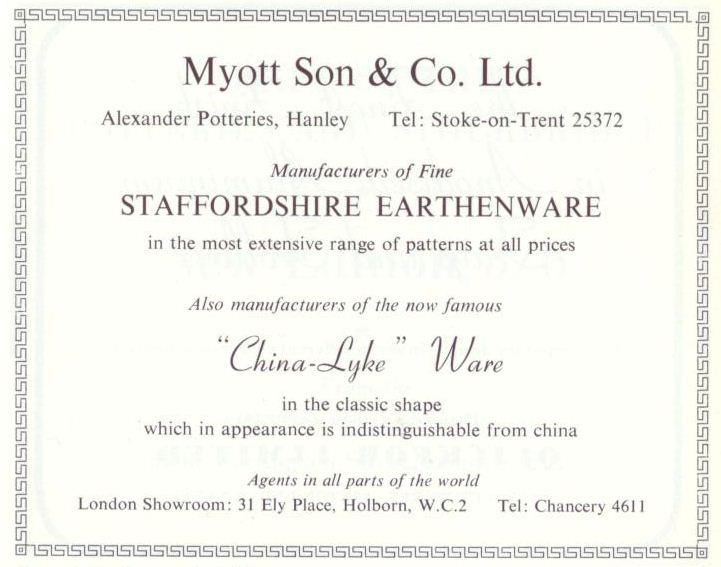
Myott Son & Co. Ltd.
Alexander Potteries, Hanley
Manufacturers of Fine
Staffordshire Earthenware
in the most extensive range of patterns at all prices
Also manufacturers of the now famous
"China-Lyke" Ware
in the classic shape
which in apperance is indistinguishable from china
Advert: The Pottery Gazette Reference Book 1960
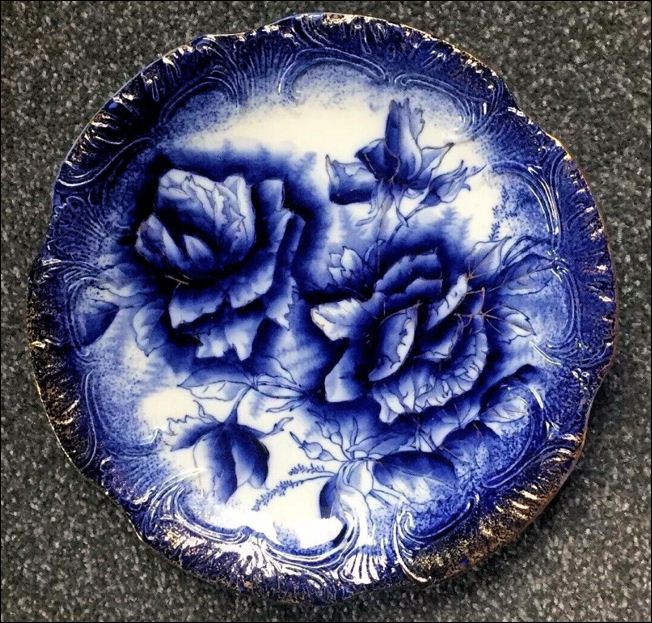 flow blue style plate with gilt - in the 'Dudley' pattern |
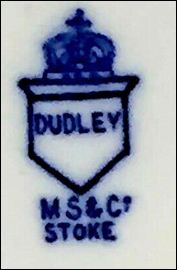 M S & Co Stoke the shield/crown style mark is based on that used by the predecessor G. T. Mountford |
produced by Myott, Son & Co at the Alexander Works, Wolf Street, Stoke between 1898 and 1902
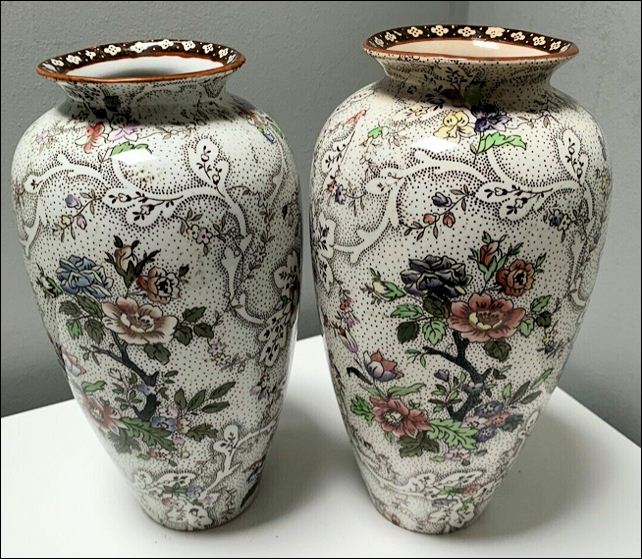
Pair of vases in the Bayeux pattern
Imperial Semi Porcelain
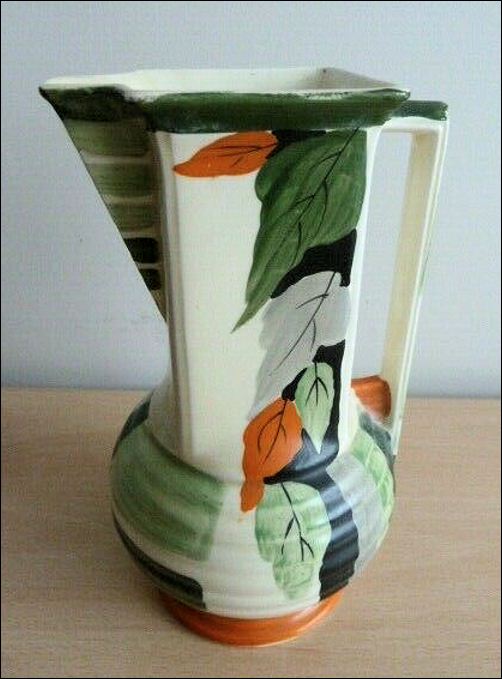
hand painted Art Deco style vasethe registration number shows that the pattern was registered in 1928
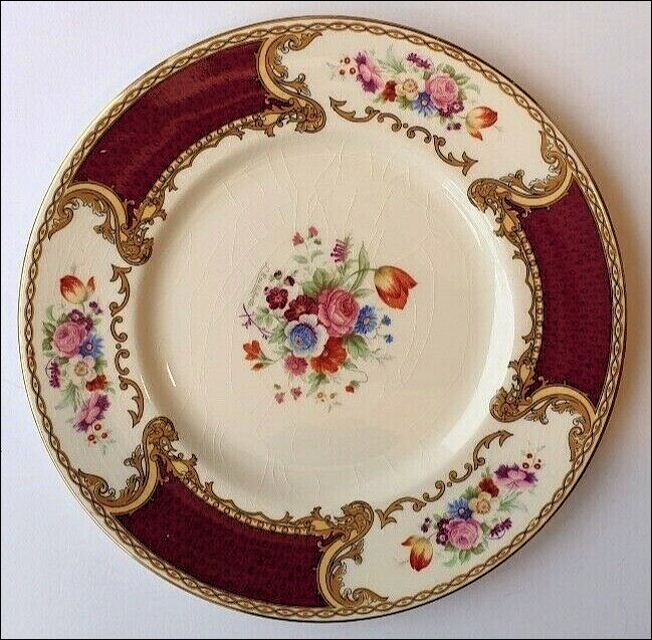
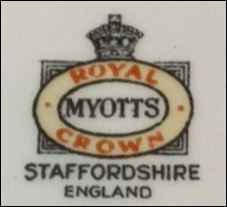
Plate in the Royal Crown Range
the pattern is 'The Bouquet'
the Royal Crown range was introduced c.1930
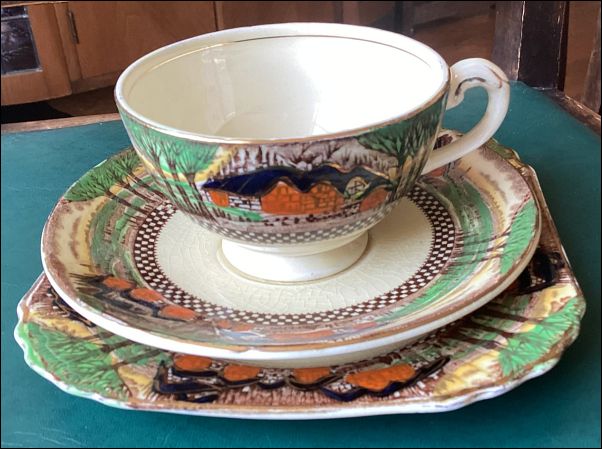
photos courtesy: Chris & Sandra Morgan |
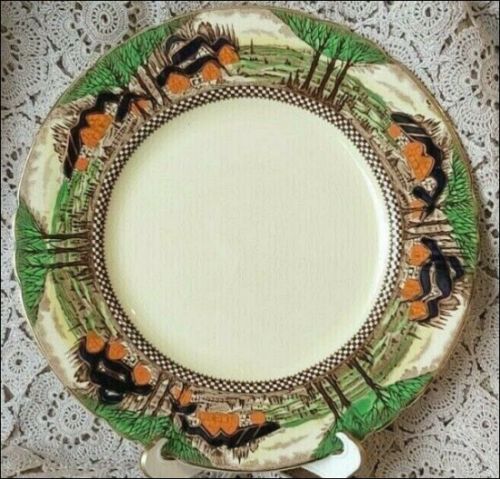
|
Myott fan vases
|
Myott fan vases are distinctive examples of Art Deco pottery produced by Myott, Son & Co. during the 1930s. These vases are characterized by their fan-shaped design and hand-painted geometric patterns. There were a number of basic shapes featuring differing designs. |
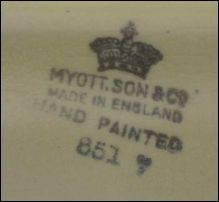
Myott Son & Co
Made in England
Hand Painted
the 851 will be a pattern number
and
will vary according to the design
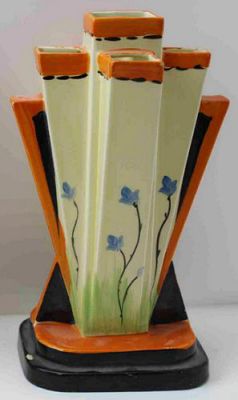
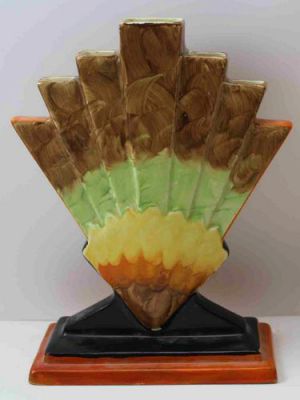
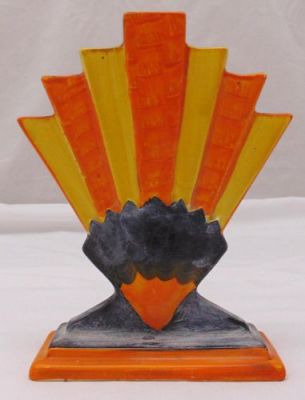
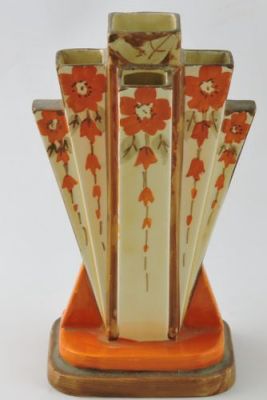
geometric fan vases with bold and striking
Art Deco patterns
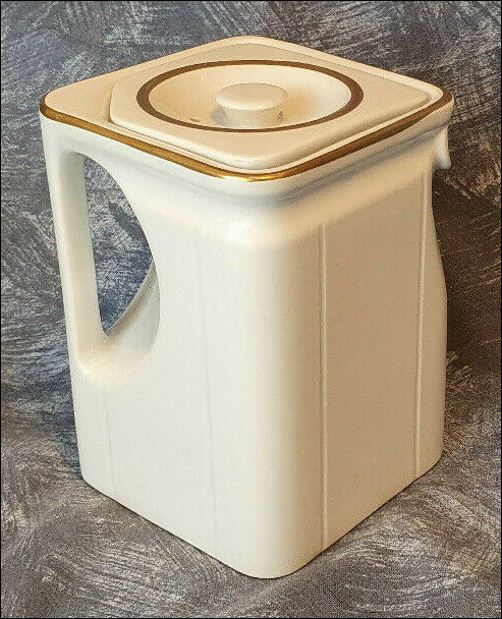
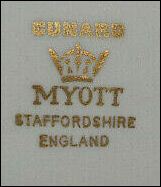
Cube teapot produced by Myott
for the Cunard ocean liners
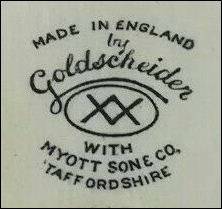
Made in England
by Goldscheider
with Myott Son & Co
Staffordshire
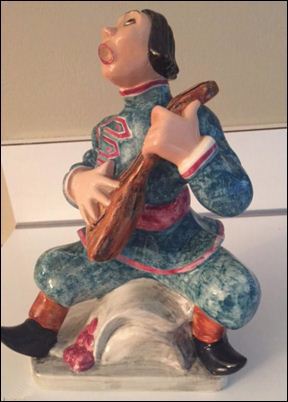
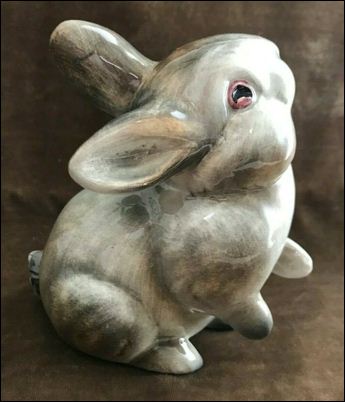
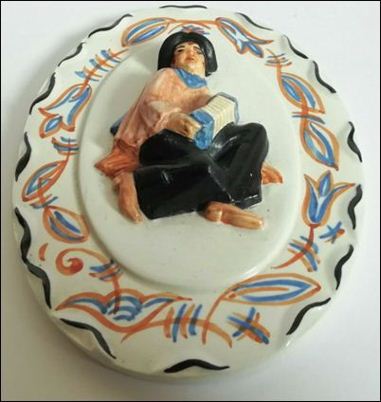
|
From around 1940 to 1950 Marcel Goldscheider ( an Austrian migrant figure modeller) was based at Myott's works and Myott produced ware to his design and on his behalf. After the fire at the Myott factory in August 1949 Goldscheider moved to his own works in John Street, Hanley. |
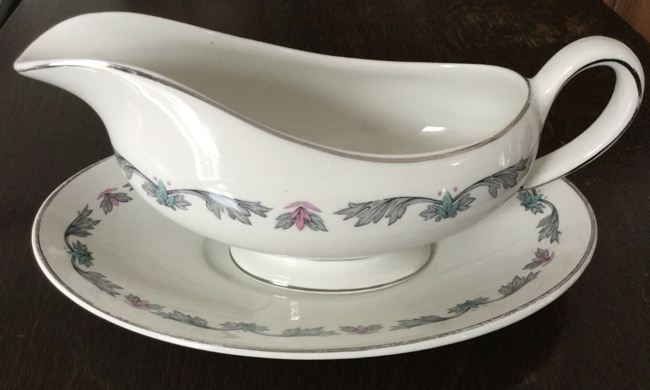
sauce boat and saucer - Dior
design
part of the
"China-Lyke" range
introduced c.1959
Bowls in the OLD ENGLAND series
one produced by Royal Sphinx in Holland
and one produced by Myott, Son & Co in England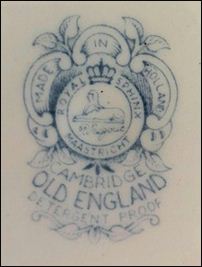
Made in Holland
Royal Sphinx
Maastricht
Cambridge
OLD ENGLAND
Made in England
Myott, Son & Co
Staffordshire
Cambridge
OLD ENGLAND
Identical pattern produced by Royal Sphinx in Holland and Myott, Son & Co in England.
It is probable that the pattern was licenced by Myott to Royal Sphinx and the transfer plates produced by the same engraver.photos courtesy: Allá Popova
Marks used on ware for identification:
M S & Co
MYOTTS
Myott Son & Co
Royal Crown
Old England

M S & Co
Stoke
1898 - 1902
DUDLEY is the pattern name
the shield/crown style mark is based on
that used by the predecessor G. T.
Mountford
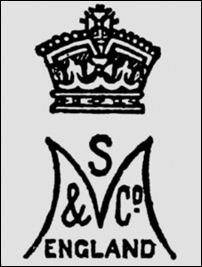 M S & Co England c.1900+
|
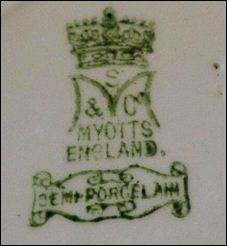 M S & Co England c.1900+ the mark appears with and without the words 'Semi Porcelain' |
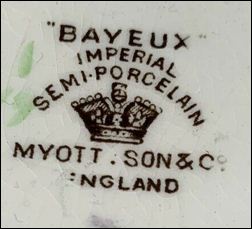 Impreial Semi Porcelain Myott Son & Co England c.1907+ BAYEUX is the pattern name |
 Myotts Royal Crown Staffordshire England c.1930+ Royal Crown isn't a pattern name - it is a range of ware |
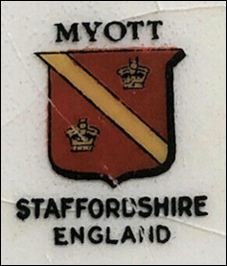 Myott Staffordshire England c.1930+ |
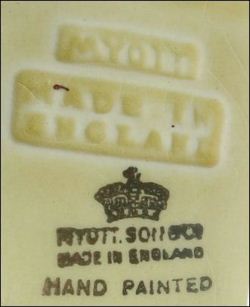 Myott Son & Co Made in England c.1936+ this marks appears with and without the impressed marks or the 'Hand Painted' |
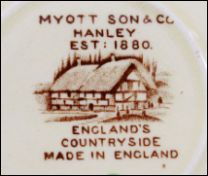 Myott Son & Co Hanley Est : 1880 England's Countryside Made in England |
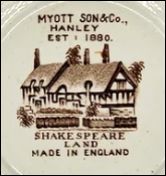 Myott Son & Co Hanley Est : 1880 Shakespeare Land Made in England |
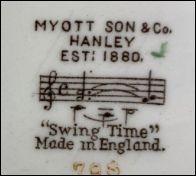 Myott Son & Co Hanley Est : 1880 "Swing Time" Made in England |
in the 1930s Myott launched a range of ware - all of which have Est : 1880
Myott Son & Co were actually
established 1898
- it was the predecessor G. T.
Mountford who was
established in 1880
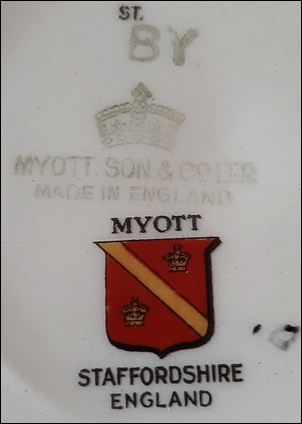
BY
Myott Son & Co Ltd
Made in England
|
Ware with the BY marks were produced between 1945 and 1952 under the Wartime Concentration Scheme. During
the Second World War production was concentrated in a reduced number of factories in order to save materials, energy and labour as these were needed elsewhere for the war. |
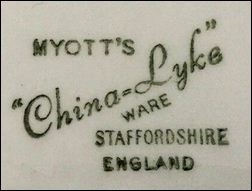 Myott's "China-Lyke" Ware Staffordshire England c.1959+ |
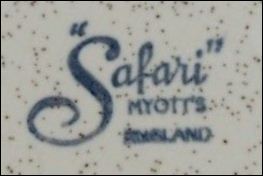 "Safari" Myott's England c.1961+ |
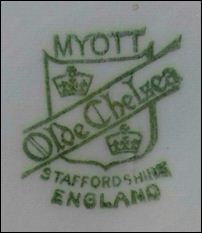 Myott Olde Chelsea Staffordshire England c.1961+ |
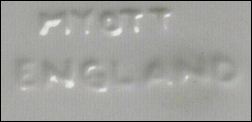
MYOTT
England
moulded mark
Factories operated by Myott:
| This summary of the Myott
manufacturing locations should help to clear up some of the confusion
surrounding their factories and location of business.
The Myott business only operated from two locations: 1. The Wolfe Street area of Stoke town - c.1898 to 1902 2. The site of the Brownfield Works on the boundary of Cobridge & Hanley - c.1902 onwards |
Wolfe Street
|
From 1880 the firm of George Thomas Mountford was operating at the Alexander pottery in the area of Stoke town which was to become Wolfe Street. Mountford died 2nd January 1898 and the Myott family purchased the Mountford business. The area around Wolfe Street was being redeveloped in the late 1890s to allow the setting out of streets and building of a market hall. |
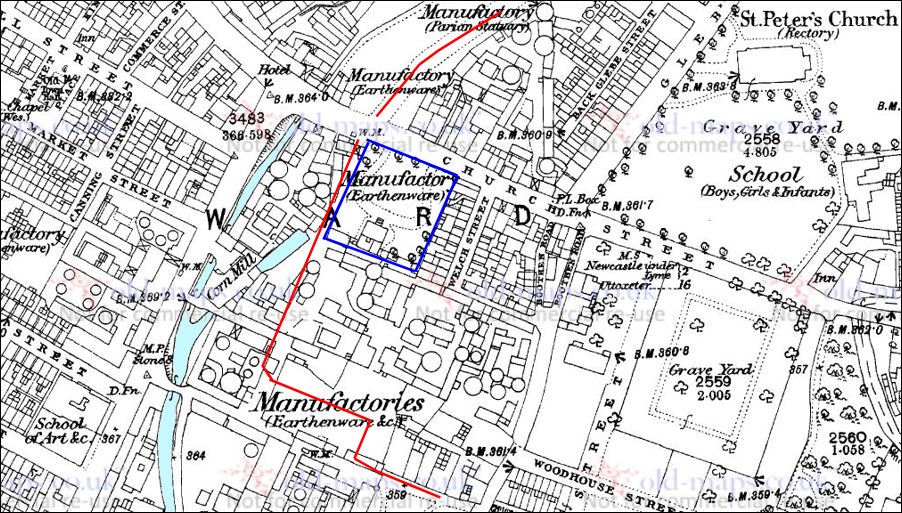
1880 map of Stoke town showing
the area where G. T. Mountford's Alexander
pottery was located
to help locate the area - top right is St.
Peter's Church and to the left is the Newcastle-under-Lyme
canal
the blue square shows a house
and gardens which was to be the location of the market hall
the red line shows the route of the yet to be built Wolfe Street
- it was in this area where the Mountford's Alexander pottery was
located
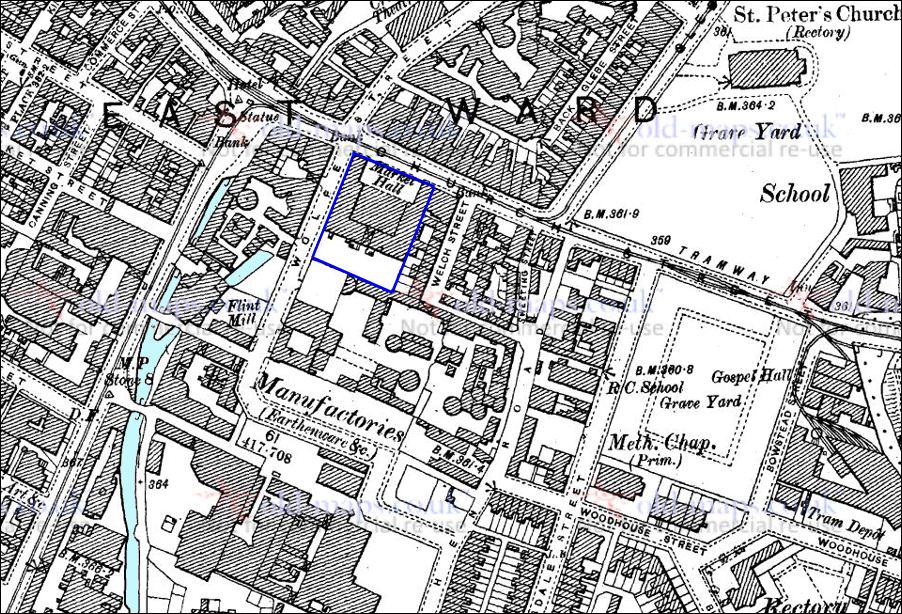
1900 map of the same area
showing the newly laid out Wolfe Street and the Market Hall
it was c.1900 that Myott acquired land on and around the W. Brownfield & Son works in Cobridge
Works at Cobridge
|
William Brownfield had a works at a major crossroads on the outskirts of Cobridge, these works were close to the boundary between Cobridge and Hanley. As
the town of Hanley grew in size and importance this area was, although
strictly in Cobridge, sometimes refered to as Hanley.
|
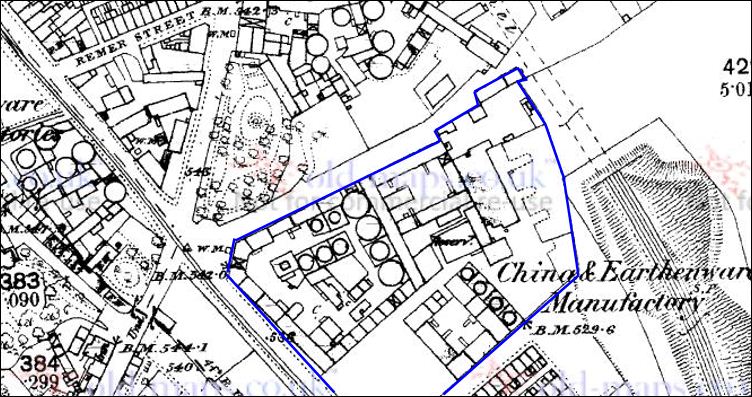
1880 map showing the extensive
Brownfield Works at the crossroads in Cobridge
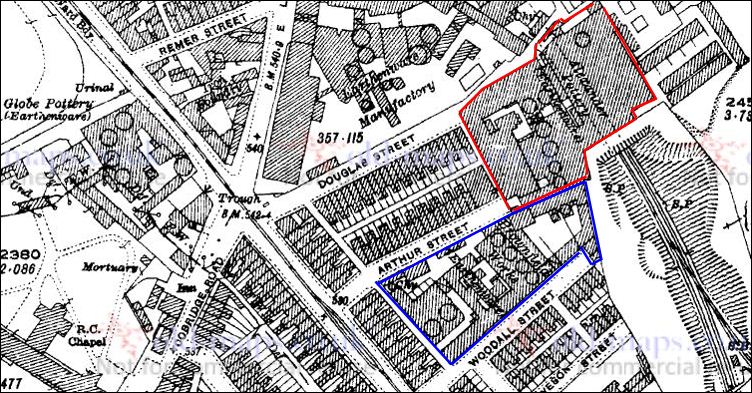
1924 map showing the devopment
of housing and the setting out of Douglas and Arthur Streets
the reduced Brownfield Works and the Alexander Pottery are shown
| In 1900 part of the
extensive Brownfield works in
Cobridge was demolished for housing development, some of the land was
acquired by Myott, in 1902 they had completed a new factory which they
also named the Alexander pottery (after the original works in Wolfe
Street, Stoke).
The Brownfield Works (reduced in size following the development of the area) was occupied by the Upper Hanley Pottery (Grimwades Ltd.) who operated there until c.1911. |
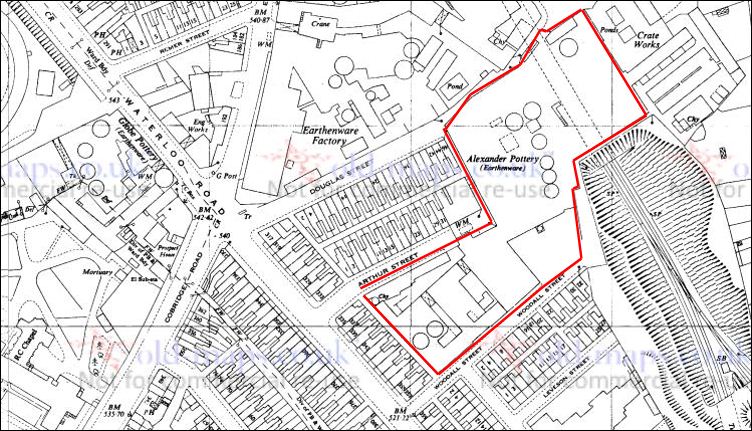
1951 map showing the much
expanded Alexander Pottery
|
In 1925 Myott expanded their works to include the adjacent Brownfield Works - the combined works was called the Alexander Potteries. In the early 1950's Arthur Street was renamed Crane Street. |
Courtesy: Old-Maps.co.uk
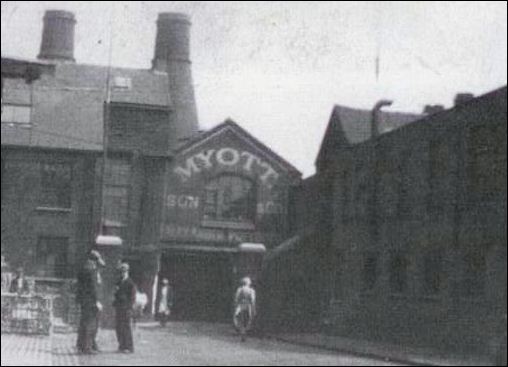
Myott Son & Co
Alexander Potteries
Arthur Street in the 1930's
- click for more information -
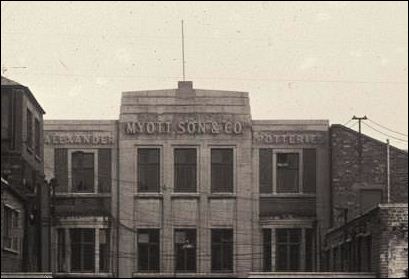
Myott Son & Co
Alexander Potteries
Crane Street in 1963
the frontage was refurbished
following the fire in 1949
Arthur Street was renamed to Crane Street in the early 1950's
Courtesy: Staffordshire Past Track
Questions, comments, contributions? email: Steve Birks